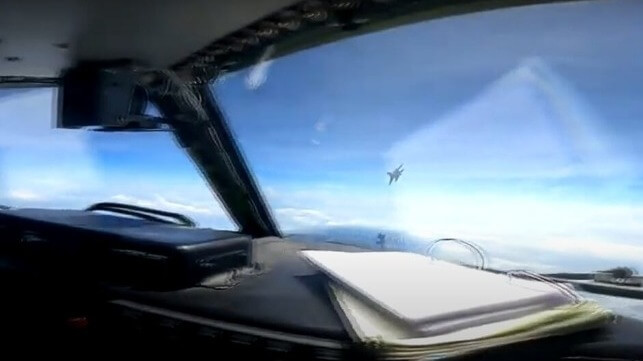U.S. Reports Dangerous Run-In With Chinese Fighter Over S. China Sea

On Wednesday, the U.S. military reported another close encounter between a Chinese fighter jet and an American surveillance aircraft over the waters of the South China Sea. The run-in is part of a pattern of harassment of U.S. and allied aircraft by Chinese forces, according to the U.S. government.
According to Indo-Pacific Command, a PLA Air Force J-16 fighter made an "unnecessarily aggressive maneuver" during the intercept of a U.S. Air Force RC-135 surveillance plane on May 26. The PRC pilot flew directly in front of the nose of the American aircraft, creating severe turbulence for the RC-135.
The RC-135 Rivet Joint is the workhorse of the U.S. Air Force's spy plane fleet, operating in various configurations since 1961. The class is a frequent sight over the contested waters of the South China Sea, where China has established a string of island military bases from Hainan to the Spratly Islands. According to the Pentagon, the plane was conducting routine operations in international airspace at the time of the intercept.
"The United States will continue to fly, sail, and operate – safely and responsibly – wherever international law allows," said U.S. Indo-Pacific Command. "We expect all countries in the Indo-Pacific region to use international airspace safely."
This is far from the first time that the U.S. has reported an aerial run-in with a Chinese fighter. In December, an RC-135 aircrew took evasive action to avoid making contact with a J-16 fighter that drifted in front of its nose.
"There have been a series of these actions directed not just at us but at other countries in recent months," said U.S. Secretary of State Anthony Blinken in a statement.
In an article published Wednesday, the opinion-focused Chinese state news outlet Global Times called for the Chinese military to deter "peeping Toms" conducting surveillance over the South China Sea. The outlet asserted that the RC-135 was surveilling the operations of PLA Navy Flotilla 17 at the time of the run-in at a position about 25 nm off China's coast. (This is far outside of the 12 nm boundary line defining international airspace.)
"The Chinese fighter jet did an outstanding job professionally in sending a warning to the US spy plane without risking a collision," Global Times asserted.
China claims the vast majority of the South China Sea as its own under its "nine-dash-line" and "enclosed-baseline" policies. The Permanent Court of Arbitration in the Hague has rejected these claims as inconsistent with the UN Convention on the Law of the Sea, but China does not recognize the ruling.
